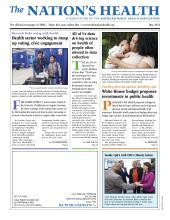
Kyra Betts holds her 5-month-old son Nathan Randy Patton Jr. in St. Louis in 2021. The president’s budget released in March proposes funding for maternal and infant health and child care, among myriad other public health needs.
Photo by Nick Schnelle, courtesy The Washington Post/Getty Images
President Joe Biden proposed a budget in March that he hopes will invest in the long-term physical, mental and financial health of all Americans. But public health experts say funding delays and budget caps may have already hamstrung its full potential.
Released March 11, the $7.3 trillion proposed U.S. budget for fiscal year 2025 promises to lower health care costs, expand mental health services, support the public health workforce, improve reproductive care and more.
The proposed budget includes $130.7 billion in discretionary funding for the U.S. Department of Health and Human Services — a $2.2 billion increase from fiscal year 2023. That total includes over $9.6 billion for the Centers for Disease Control and Prevention — a $499 million increase — and a discretionary budget of $8.2 billion for the Health Resources and Services Administration — a $1.2 billion decrease.
The proposals come within the confines of budget caps reached under a debt ceiling agreement signed into law in June 2023 that limited government spending. In addition, as of March, Congress had yet to approve a full fiscal year 2024 budget, prompting lawmakers to pass continuing resolutions to keep funding the federal government.
The president’s budget would “strengthen the nation’s public health infrastructure and workforce, enhance pandemic preparedness capabilities and expand access to quality health coverage for millions of uninsured individuals,” APHA Executive Director Georges Benjamin, MD, said in a news release.

Photo by Nature, courtesy iStockphoto
Despite the caps, the proposed budget for CDC calls for a $129 million increase in chronic disease prevention and health promotion, a $182 million increase for injury prevention activities such as community and youth violence prevention, and a $50 million increase to boost immunization and response to respiratory diseases.
The increase for chronic disease prevention is especially important given that some members of Congress have floated the idea of removing chronic disease work from CDC, said Adriane Casalotti, MPH, MSW, chief of government and public affairs for the National Association of County and City Health Officials. The funding is often used across multiple areas, including tobacco use prevention, school health and cancer prevention.
Yet funding has remained flat since fiscal year 2023 for CDC program support, which spans areas such as disease forecasting, the Preventive Health and Health Services Block Grant, and public health infrastructure and capacity — the latter of which was budgeted at $350 million. The lack of increase for infrastructure and capacity funding in the president’s new budget proposal isa missed opportunity, Casalotti said.
“Right now, the $350 million isn’t sufficient to really reach the local health department level in as meaningful a way as it could with some additional resources,” Casalotti told The Nation’s Health. “(I’m) excited to see the program continue to be supported by the president’s budget, but certainly was looking for an increase in that space as well.”
At HRSA, the budget proposed $1.8 billion for the Maternal and Child Health Bureau — a $135.7 million increase that maintains services such as the Maternal and Child Health Block Grant, which states use to lower infant mortality and help women and children access preventive care. The budget also recommended $390 million for HRSA’s Title X Family Planning Program, which is the only federal program to fund access to services such as birth control and pregnancy counseling, treatment for sexually transmitted infections and more.
Krystal Leaphart, senior policy analyst for Reproductive Health Impact, said she was excited to see the proposed increases. But she recognized progress does not happen in silos —reproductive health intersects with progress made in access to housing, child care, family leave and employment as well.
“There’s still a lot of work to be done in regard to how we think about all of these issues threaded together,” Leaphart told The Nation’s Health.
The White House proposed an $8.1 billion budget for the Substance Abuse and Mental Health Services Administration — a $612 million increase from fiscal year 2023.
Among the SAMHSA highlights is increased funding for the 988 Suicide and Crisis Lifeline to support Spanish speakers, LGBTQ+ youth and people who are deaf and hard of hearing. Since its transition from a 10-digit number in July 2022, the lifeline has received more than 8.6 million calls, chats and texts, according to SAMHSA. It is expected to engage with 7.5 million people in 2025.
The investment in 988 has been a hallmark of Biden’s administration, said Hannah Wesolowski, MPA, chief advocacy officer for the National Alliance on Mental Illness. She also praised a $50 million proposed increase for a project that builds mental health education resiliency and resources in schools.
“We as a nation underinvested in mental health for decades and decades,” Wesolowski told The Nation’s Health. “We’re really at a crisis point and these investments are absolutely critical.”
New investments in the budget include a proposed program to monitor, screen, prevent and treat hepatitis C and a new Vaccines for Adults program to provide uninsured adults free vaccinations.
When it comes to occupational health, the budget calls for a $2 billion investment — a $121 million increase from fiscal year 2023 — to ensure employees are fairly compensated and working in safe and healthy conditions. The funding would also address child labor exploitation and the illegal hiring of children in the workplace, which has increased by 88% since 2019, according to the Department of Labor.
“We are laser-focused on building the high road in employment while combating the low road to deliver access to high-quality jobs, fairness, safety and dignity in every community,” acting DOL Secretary Julie Su said in a news release.
The fiscal year 2025 budget proposal would also address:
Community health
The budget would provide $1.5 billion for the Environmental Protection Agency’s Office of Air and Radiation — an increase of $690 million since the start of Biden’s term — to further work on air pollution and radiation exposure programs, laws and policies.
Invest nearly $1.5 billion in environmental justice-related programs to promote clean water and air for marginalized populations, including tribal and rural communities.
Give the Indian Health Service $8 billion in discretionary funding, with $260 million for the Special Diabetes Program for Indians; a continued push toward mandatory funding for IHS in fiscal year 2026; and long-term budget plans to offer more direct care services and update electronic health records.
Family health
The budget would earmark an additional $500 million for the Child Care and Development Block Grant to help families pay for child care and support child care providers.
Provide $4.1 billion for the Low-Income Home Energy Assistance Program to help people afford utility bills and weatherize their homes against the effects of climate change and extreme weather events.
Earmark $7.7 billion for the Special Supplemental Nutrition Program for Women, Infants and Children to provide access to nutritious food and services.
Health care
The budget would cement permanent premium tax credits to help people afford health insurance through the Affordable Care Act, continue to cap the cost of insulin at $35 a month and negotiate lower drug prices for prescriptions for Medicare recipients via the Inflation Reduction Act.
Permit states to provide continuous Children’s Health Insurance Program coverage to children from birth until age 6 and for 36-month periods instead of 12 months.
Allot an additional $275 million over 10 years to the Department of Labor to make sure employers provide health insurance plans with mental health and substance use disorder coverage, including access to a network of behavioral health providers.
Advocacy can help influence Congress
Planning for next year’s budget when fiscal year 2024 funding has yet to be settled has been difficult, said Erin Will Morton, MA, executive director of the Coalition for Health Funding. Despite being told that level funding is the best public health advocates can hope for, Morton has said advocates have not backed down.
“There’s lots of different programs, lots of different advocacy groups that are…pushing for those numbers to be higher,” Morton told The Nation’s Health. “That’s really important and I think that’s our job as advocates, to be moving the needle where we think it should be.”
While Congress must now review the proposed budget and make compromises on the final funding numbers, the most critical thing for lawmakers to do now is pass full-year appropriations for 2024, said Dara Lieberman, MPP, director of government relations for Trust for America’s Health.
“It’s really up to Congress now to learn the lessons of the last four years and try to invest in healthier communities and a stronger public health system,” Lieberman told The Nation’s Health.
For more information on the proposed fiscal year 2025 budget, visit www.whitehouse.gov/omb/budget.
- Copyright The Nation’s Health, American Public Health Association









